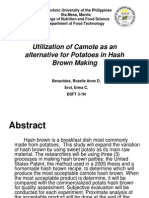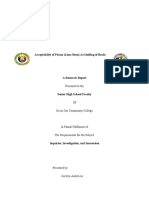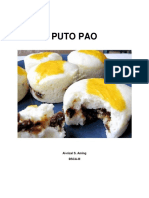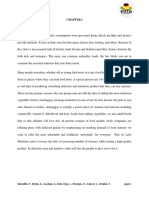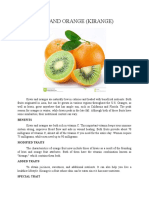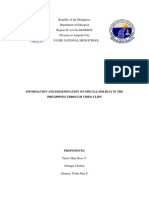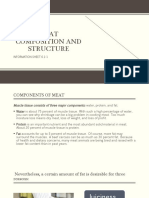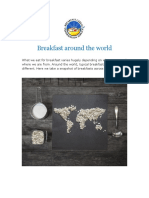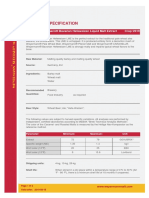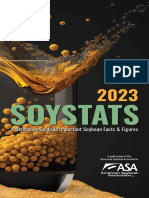Research
Research
Uploaded by
Armand James OcliasoCopyright:
Available Formats
Research
Research
Uploaded by
Armand James OcliasoOriginal Title
Copyright
Available Formats
Share this document
Did you find this document useful?
Is this content inappropriate?
Copyright:
Available Formats
Research
Research
Uploaded by
Armand James OcliasoCopyright:
Available Formats
Republic of the Philippines
Technical Education and Skills Development Authority
Caraga Administrative Region
NORTHERN MINDANAO SCHOOL OF FISHERIES
Matabao, Buenavista, Agusan del Norte
SEAWEEDS MAJA BLANCA; ITS PATABILITY AND ADAPTABILITY
Submitted in Partial Fulfillment of The
Academic Requirements inPractical Research 1
Nemia M. Gelbolingo
Ma. Leah Sabanal
CHAPTER 1 : INTRODUCTION
Introduction
Maja Blanca has a rich historical background having originated from Spain and was adapted from the traditional Spanish holiday referred to as
Manjar Blanco, which actually means white delicacy. Maja Blanca is a Filipino dessert primarily made of creamy, dense coconut pudding made
with coconut milk, grated coconut, evaporated milk or sweetened condensed milk, cornstarch, and sugar.
The Seaweed aims have a side effects of a seaweeds A small 2020 study suggests that consuming seaweed may cause high iodine exposure,
which can lead to a thyroid condition. A 2019 review notes that seaweed may also contain heavy metals. Though the amounts are usually not
toxic, consuming seaweed in large quantities can cause arsenic bioaccumulation. have so much iodine that consumers are advised to eat it no
more than three times per week. Since the concentration of specific nutrients in seaweed can interact with various medications, check with
your doctor if you have a thyroid condition or take blood thinners before going all in.
However, maja blanca into seaweeds have a healthy recipe since it has coconut milk that helps our body build and maintain strong bones. It
also has Vitamin C that boosts our immune system to defend us from health risks. consistency of thick gelatine and a delicate flavor, and is
creamy white in color.
Origin and justification
Maja blanca
Objectives of the Study
1. To develop new products – maintaining quality of other maja blanca
2. To determine whether or not consumers like the taste of the new recipe of seaweeds maja blanca
3. To observe the plesantness and taste of seaweeds maja blanca
Significance of the study
Making a new specialty of maja blanca using seaweeds is new to the market, we develop the seaweeds maja blanca to determine if it is the
same of the other maja blanca if we can achieved the appearance and quality of our innovation, we knew seaweeds are briny and salty we
conduct this research to know if we can remove the saltiness in the seaweeds so that it can not effect the taste of maja blanca because we
knew maja blanca should be sweet and pleasant.
Seaweeds has some serious benefits of the skin, it can hydrates our skin, volumizes, help feight aging, and it can protect our skin in sun damage.
We well remove the saltiness of the seaweeds so that costumer enjoy eating the dessert. Conducting this study is important because seaweeds
have many benefits to our health.
Scope and limitation of the study
CHAPTER II
CONCEPTUAL FRAMEWORK
Review of Related Literature and Studies
Historically known as the significant pearl produce, the Philippines were given a fitting romantic name – Perla del Mar de Oriente (Pearl of the
Orient Seas) by Spanish Jesuit Missionary Fr. Juan J. Delgado in 1751. Though the Philippine cuisine assimilated food traditions of neighbouring
Asian nations, it is apparently the product of the local unique geography, terrain, climate, flora and fauna. Consisting of more than 7,100
islands, the Philippines is well known for its vast high and lowlands, tropical climate, rich coastal waters, frequent typhoons, tsunamis and
earthquakes. Rice, fish, poultry, fresh vegetables, tropical fruits, coconuts, goat or carabao buffalo milk are the food staples of Filipinos. Being
the basic staple, rice was given its own Filipino name, kanin. It is a common recipe ingredient from starter courses to various rice cakes and
other sweetmeats called kakanin. Filipinos like to have two to three additional meals a day besides the three main ones, with desserts used as
snacks. Apart from kakanin, Filipino cookery proposes a variety of non-rice sweet desserts with maja blanca being one of them. Made primarily
from coconut milk it’s also known as coconut pudding. The name of the traditional holiday dessert is actually of Spanish origin. Initially
pronounced as manjar blanco it means “white delicacy”. This sweet coconut pudding is a wonderful treat and is usually served during fiestas
and holidays, especially Christmas. There are many variations of the recipe because maja blanca can easily be modified with different
ingredients. For example squash maja blanca contains calabazas (West Indian pumpkin), whereas maja mais includes sweet corn cream style
giving it a pretty yellow colour. There’s also maja ube using ube (purple yam) as a distinct ingredient which gives it a vivid purple-to-bright
lavender colour. Our flavourful sweet recipe contains evaporated milk which is typically used in the original maja preparations.
You might also like
- Healthy FoodDocument13 pagesHealthy Food5ftheroes100% (6)
- TaroStarch FeasibilityStudyDocument142 pagesTaroStarch FeasibilityStudyPatrick SumeguinNo ratings yet
- Shiela's DE COCO'S DE TURONDocument27 pagesShiela's DE COCO'S DE TURONMary Grace Jerna Artazo Nozal-CuadraNo ratings yet
- Graham Ball Malunggay BPDocument4 pagesGraham Ball Malunggay BPErica Joy Flores Placides100% (1)
- Research Camote Hash BrownDocument20 pagesResearch Camote Hash BrownRoma Benavides60% (5)
- Acceptability of Patani (Lima Bean) As Stuffing of Buchi: Presented To TheDocument30 pagesAcceptability of Patani (Lima Bean) As Stuffing of Buchi: Presented To TheTubon, Erika May A.100% (1)
- Chapter 1Document9 pagesChapter 1Roxanne MaeNo ratings yet
- Puto Pao: Al-Nizal S. Aming Bsca-IiiDocument4 pagesPuto Pao: Al-Nizal S. Aming Bsca-Iiimu muNo ratings yet
- Group-2 Bm2ma ResearchDocument21 pagesGroup-2 Bm2ma ResearchpaulaNo ratings yet
- Ampalaya Milk Tea Full Paper 1 1 1Document49 pagesAmpalaya Milk Tea Full Paper 1 1 1Aicelle Calindas100% (1)
- Consumer Preference Among Different Pandesal Variants He StudentDocument4 pagesConsumer Preference Among Different Pandesal Variants He StudentRicardo TabasaNo ratings yet
- Acceptability of Cassava (Manihot Esculenta) in Baking BrowniesDocument10 pagesAcceptability of Cassava (Manihot Esculenta) in Baking BrowniesTappy Hioka100% (1)
- Purposive ResearchDocument8 pagesPurposive ResearchRomulo Rosario Marquez0% (1)
- Banana Blossom ChipsDocument1 pageBanana Blossom ChipsAviorie GaanoNo ratings yet
- Chapter IvDocument13 pagesChapter IvEnnavy YongkolNo ratings yet
- AngkoDocument2 pagesAngkoPhillip GabaynoNo ratings yet
- Leche GulamanDocument13 pagesLeche Gulamanroneldayo62100% (2)
- Final Chapters-1Document14 pagesFinal Chapters-1Malote Elimanco AlabaNo ratings yet
- General Luna Road, Baguio City Philippines 2600: Material ItselfDocument10 pagesGeneral Luna Road, Baguio City Philippines 2600: Material ItselfLaarnie LinggayoNo ratings yet
- Development of Pomelo Bar With Shortbread Crust Edited 1Document45 pagesDevelopment of Pomelo Bar With Shortbread Crust Edited 1Jain EpifanioNo ratings yet
- Perceived Benefits of Leaves Extract of Sambong As A Biopesticide in Negros Occidental 1 1Document13 pagesPerceived Benefits of Leaves Extract of Sambong As A Biopesticide in Negros Occidental 1 1RD SuarezNo ratings yet
- References Leche FlanDocument2 pagesReferences Leche FlanEivor LynNo ratings yet
- PR 2021Document30 pagesPR 2021Shairamie P. QuiapoNo ratings yet
- Capstone Project Final PaperDocument32 pagesCapstone Project Final PaperAbraham Kashmier L AliNo ratings yet
- Chapter IvDocument9 pagesChapter IvJoan RosarioNo ratings yet
- The Efficiency of Ube Maja BlancaDocument8 pagesThe Efficiency of Ube Maja BlancaJamaica Calamba DumaguitNo ratings yet
- RRL Carrot Potato Balls 1Document7 pagesRRL Carrot Potato Balls 1Villamor Ace TagubaNo ratings yet
- Development and Acceptability of Organic Soap From Pansit-Pansitan (Peperomia Pellucida)Document30 pagesDevelopment and Acceptability of Organic Soap From Pansit-Pansitan (Peperomia Pellucida)MimimmirNo ratings yet
- ACTIVITY 1. Determining An Outdoor Recreational ActivityDocument4 pagesACTIVITY 1. Determining An Outdoor Recreational ActivityMariela FrancoNo ratings yet
- Tuna Pine ProducrDocument15 pagesTuna Pine ProducrDecieryl MontanaNo ratings yet
- Banana Cookies.1Document47 pagesBanana Cookies.1Ron D. ArtNo ratings yet
- Bunotare A Proposed Indoor Slippers Through The Feasibility of Rice Straws and Coconut HusksDocument51 pagesBunotare A Proposed Indoor Slippers Through The Feasibility of Rice Straws and Coconut HusksRyan Lorenzo Garcia PerezNo ratings yet
- Chapter 1 EntrepDocument5 pagesChapter 1 EntrepKaren DyNo ratings yet
- LakatanDocument1 pageLakatankurt pro100% (1)
- Feasibility of Colocasia Esculenta As An Alternative FlourDocument9 pagesFeasibility of Colocasia Esculenta As An Alternative FlourMary GraceNo ratings yet
- Kamote Tops (Ipomoeia Batatas Linn) Decoction Into JuiceDocument5 pagesKamote Tops (Ipomoeia Batatas Linn) Decoction Into JuiceTata KurtoNo ratings yet
- PE LetsDoThisDocument2 pagesPE LetsDoThisVine ErispeNo ratings yet
- CHAPTER 7 - Nature and Background of Outdoor RecreationDocument7 pagesCHAPTER 7 - Nature and Background of Outdoor RecreationDanielyn GestopaNo ratings yet
- Kiwi and OrangeDocument2 pagesKiwi and OrangeCarl Canonigo SebialNo ratings yet
- Thesis Border 2014 NceDocument54 pagesThesis Border 2014 NceJJ THOMPSONNo ratings yet
- UCSPDocument2 pagesUCSPJerome CaladiaoNo ratings yet
- Research ProposalDocument9 pagesResearch ProposalMika PatocNo ratings yet
- "Better Bitter (Momordica Charantia) Gourd Cookies": MembersDocument5 pages"Better Bitter (Momordica Charantia) Gourd Cookies": MembersLemuel Jefferson CastilloNo ratings yet
- Final Research PaperDocument11 pagesFinal Research Paperapi-546795600No ratings yet
- Fatima, The War Nurse: Stories About War and Peace in Philippine LiteratureDocument8 pagesFatima, The War Nurse: Stories About War and Peace in Philippine LiteraturenicoleNo ratings yet
- The Benefits of Coconut Shell To Daily Life of Selected Student of Grade 9 in Buhaynasapa National High SchoolDocument9 pagesThe Benefits of Coconut Shell To Daily Life of Selected Student of Grade 9 in Buhaynasapa National High SchoolJohn Paul IlaoNo ratings yet
- Practical Research 1Document65 pagesPractical Research 1Zeke YurixoNo ratings yet
- Scope and DelimitationDocument1 pageScope and DelimitationTricia ArboNo ratings yet
- Business PlanDocument9 pagesBusiness PlanKristine Andrea AngNo ratings yet
- Oregano Perfume FinalDocument15 pagesOregano Perfume FinalMarc Neil Cintron100% (1)
- Conceptual Framework and Review of Related LiteratureDocument6 pagesConceptual Framework and Review of Related Literaturewayne perezNo ratings yet
- Background of The StudyDocument5 pagesBackground of The StudyJoshua OrtezNo ratings yet
- Review of Related LiteratureDocument3 pagesReview of Related LiteratureRiabel BurlazaNo ratings yet
- Triple IDocument11 pagesTriple ITrishaMaePanganibanAbainzaNo ratings yet
- Local RRL 2Document77 pagesLocal RRL 2sheila rose lumaygayNo ratings yet
- The FINAL RESEARCH Vinaigrette Pickled TurnipDocument28 pagesThe FINAL RESEARCH Vinaigrette Pickled TurnipJoerey FernandezNo ratings yet
- Questionnaire (Implications of Cassava)Document7 pagesQuestionnaire (Implications of Cassava)Montesa EnclonarNo ratings yet
- Ginger CandyDocument8 pagesGinger CandyRizka Arifani Kromodimedjo100% (2)
- A Feasibility Study OnDocument11 pagesA Feasibility Study OnMariah Shayla BuenaNo ratings yet
- Chapter 1Document20 pagesChapter 1Geoana Jane BadenasNo ratings yet
- Pilar of Mindanao: A Story of Courage and Love in World War IiFrom EverandPilar of Mindanao: A Story of Courage and Love in World War IiNo ratings yet
- Buwan NG Wika ProgramDocument2 pagesBuwan NG Wika ProgramArmand James OcliasoNo ratings yet
- STATISTICS and PROBABILITY PPT1Document15 pagesSTATISTICS and PROBABILITY PPT1Armand James OcliasoNo ratings yet
- STATISTICS and PROBABILITY PPT2Document11 pagesSTATISTICS and PROBABILITY PPT2Armand James OcliasoNo ratings yet
- STATISTICS and PROBABILITY PPT4Document19 pagesSTATISTICS and PROBABILITY PPT4Armand James OcliasoNo ratings yet
- Region 8 - Eastern VisayasDocument35 pagesRegion 8 - Eastern VisayasArmand James OcliasoNo ratings yet
- Types of MediaDocument11 pagesTypes of MediaArmand James OcliasoNo ratings yet
- 4ESO R&C Practice Test 2nd TermDocument4 pages4ESO R&C Practice Test 2nd Termauauau33auNo ratings yet
- Choux Temptations-Jayca (2021)Document105 pagesChoux Temptations-Jayca (2021)elkhayyalmustaphaNo ratings yet
- Use of Kitchen Tools Equipment and ParaphernaliasDocument8 pagesUse of Kitchen Tools Equipment and ParaphernaliasajudegarciaNo ratings yet
- Week 5Document4 pagesWeek 5Bryan SmileNo ratings yet
- Therapeutic Diet - TypesDocument7 pagesTherapeutic Diet - TypesJEEJANo ratings yet
- Spanish GCSE VocabularyDocument30 pagesSpanish GCSE VocabularyVictor Perea100% (3)
- Modal Kotak Dan SetDocument27 pagesModal Kotak Dan SetAmira Natasha00No ratings yet
- Activity Sheet 1 - TLE - Gr.9 - Bread and Pastry Production - Culinary Terms Related To Bakery ProductsDocument2 pagesActivity Sheet 1 - TLE - Gr.9 - Bread and Pastry Production - Culinary Terms Related To Bakery ProductsCharielyTamparong100% (5)
- MasterChef Kitchen Bible Everything You Need To Take Your Cooking To The Next LevelDocument1,411 pagesMasterChef Kitchen Bible Everything You Need To Take Your Cooking To The Next LevelAncuța-Ionela Năstase100% (12)
- Daily Menu For Pregnant WomanDocument68 pagesDaily Menu For Pregnant WomanPapătot PapătotNo ratings yet
- Info Sheet 6.1-1 MEAT COMPOSITION AND STRUCTUREDocument18 pagesInfo Sheet 6.1-1 MEAT COMPOSITION AND STRUCTUREOubli Bonheur100% (1)
- Breakfast Around The WorldDocument14 pagesBreakfast Around The WorldLaura noguesNo ratings yet
- "Katori Chaat" Heavenly Taste Filled in BasketDocument6 pages"Katori Chaat" Heavenly Taste Filled in BasketNimmi NimsNo ratings yet
- Sequence and Script For Restaurant ServiceDocument6 pagesSequence and Script For Restaurant ServiceMac Bellosillo100% (1)
- Meeting Package On WebDocument8 pagesMeeting Package On Webyohanes hendraNo ratings yet
- Bavarian Hefeweizen Liquid Malt Extract Specification PDFDocument2 pagesBavarian Hefeweizen Liquid Malt Extract Specification PDFCarmineD'AnielloNo ratings yet
- 1 Training Activity MatrixDocument6 pages1 Training Activity MatrixTesda Sfist71% (7)
- James Sampan Copies and Scripts Portfolio 2014Document45 pagesJames Sampan Copies and Scripts Portfolio 2014jamessampanNo ratings yet
- 2-Jrefarticle 1Document17 pages2-Jrefarticle 1manibhargaviNo ratings yet
- Calorii CondimenteDocument2 pagesCalorii CondimenteStefania CiobarcianuNo ratings yet
- Classic Lemon Meringue PieDocument3 pagesClassic Lemon Meringue PieAloma Grace JuicoNo ratings yet
- Soy Stats 2023 WebDocument36 pagesSoy Stats 2023 WebjohnnyNo ratings yet
- Virus CovidDocument41 pagesVirus CovidYvala Zamora PercyNo ratings yet
- 25 Burger Recipes by Gooseberry PatchDocument27 pages25 Burger Recipes by Gooseberry PatchGooseberry Patch86% (7)
- Integrated Grammar Worksheet - 2Document4 pagesIntegrated Grammar Worksheet - 2Kanica SoniNo ratings yet
- De Thi Hoc Ki 1 Tieng Anh 7 Global Success de So 1 1668660407Document4 pagesDe Thi Hoc Ki 1 Tieng Anh 7 Global Success de So 1 1668660407Quỳnh PhạmNo ratings yet
- Chart For FoodDocument1 pageChart For FoodMukaddas Pinjari /MUM/FSC/FCONo ratings yet
- Food and Drinks Fun Activities Games Grammar Drills Grammar Guides - 86151Document3 pagesFood and Drinks Fun Activities Games Grammar Drills Grammar Guides - 86151Cida Feitosa0% (1)
- List of All Cooking Recipe in Ragnarok M Eternal LoveDocument23 pagesList of All Cooking Recipe in Ragnarok M Eternal LoveRifandry FitraNo ratings yet




